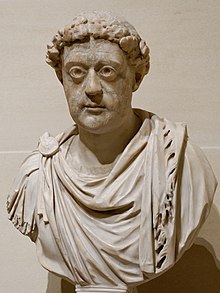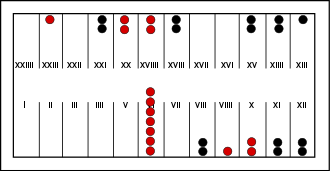Zeno (emperor)
Born in Isauria, Zeno was known as Tarasis before adopting his Greek name and becoming an ally of Emperor Leo I, who saw the Isaurian general as an important counterweight against the Germanic leader Aspar.In early 475, he was forced to flee Constantinople in a revolt orchestrated in part by dowager Empress Verina, which concluded with Leo I's brother-in-law Basiliscus installing himself as emperor.Seeking refuge in his native Isauria, Zeno later took advantage of Basiliscus's own flagging popularity, convinced the generals Illus and Armatus to defect, marched on the capital and reclaimed the throne in mid-476.Following Strabo's early death, Zeno was able to achieve a lasting peace with Theodoric by sending him to Italy, where he defeated Odoacer and established the Ostrogothic Kingdom.In religious matters, Zeno issued the Henotikon in 482 on the advice of Acacius, the Patriarch of Constantinople, in an unsuccessful attempt to reconcile the differences between the Chalcedonians and the Miaphysites over the nature of Christ.[4] Near Eastern and other Christian traditions maintain that Zeno had two daughters, Hilaria and Theopiste, who followed a religious life,[5] but historical sources attest the existence of only one son by Arcadia, called Zenon.[3] According to some scholars, in the mid-460s, the Eastern Roman Emperor, Leo I, wanted to balance the weight of the Germanic component of the army, whose leader was the Alan magister militum Aspar.Through these letters, which Tarasis gave to Leo, the Emperor could dismiss Ardabur, who at the time was magister militum per Orientem and patricius, thus reducing Aspar's influence and ambition.In mid-late 466, Zeno married Ariadne, elder daughter of Leo I and Verina; there is no reference to him divorcing Arcadia who evidently died prior to this.[15] While living in Antioch with his family, Zeno sympathised with the Monophysite views of Peter the Fuller, and supported him against his opponent, the Chalcedonian bishop Martyrius.Leo reacted by ordering Peter into exile and addressing to Zeno a law that forbade the monks from leaving their monasteries or fomenting rebellion (1 June 471).Zeno had to settle matters with the Vandal King, Genseric, who was conducting raids against the Empire's coastal cities, threatening key commercial sea routes.[23] Despite this success, Zeno continued to be unpopular with the people and Senate because of his barbarian origins; his right to the throne was limited to his marriage with Ariadne and his relationship to Verina, the dowager Empress.The conspirators fomented riots in the capital against the Isaurian emperor; Basiliscus succeeded also in convincing Illus, Trocundes and the Ostrogothic general Theodoric Strabo to join the plot.[25][27][28] After his restoration, Zeno fulfilled his promises, letting Armatus keep his title of magister militum praesentalis (possibly even raising him to the rank of patricius) and appointing his son Basiliscus Caesar in Nicaea.They asked Zeno to dissolve the separation of the empire and rule as sole Emperor; also, to appoint Odoacer both patricius and official imperial governor of Italy.Perhaps in deference to Zeno, Odoacer recognised Nepos' de jure reign in Italy until his death, ruling and even minting coins in his name, but he never allowed his return.During the night, however, Illus moved an Isaurian unit, quartered in nearby Chalcedonia, into Constantinople and also corrupted Marcian's soldiers, who allowed Zeno to flee.The following morning, Marcian, understanding that his situation was desperate and that reinforcements from Theodoric Strabo would not arrive in time, took refuge in the church of the Holy Apostles, but was arrested with his brothers.Zeno sent an army to fight them, but Illus won, obtained possession of Papurius, released Verina, and induced her to crown Leontius at Tarsus.The Imperial army obtained some initial successes, but Zeno did not press his advantage, and allowed the Amal to move westward in Thrace, plundering territories as he went.[41] After Theodoric Strabo died in 481, the future Theoderic the Great became king of the entire Ostrogoth nation and continued to be a source of trouble in the Balkan peninsula.Zeno allied to Theoderic, whom he appointed magister militum praesentalis and even consul for the year 484, the first time a barbarian who was not a citizen of the Empire reached such a high distinction.Zeno bought a peace and agreed with Theoderic that the Ostrogoths should have gone to invade Italy to fight Odoacer, who had allegedly supported Leontius, and to establish his new kingdom there (487).[42] In religious matters, Zeno is famous for his Henotikon, or "Act of Union", issued in 482 to mediate between Chalcedonian and Miaphysite views about the nature of Christ.[43] The bishop of Rome, Pope Felix III, refused to accept the document and excommunicated Acacius (484), thus beginning the Acacian schism, which lasted until 519.The rebels attacked Sichem, burnt five churches built on Samaritan holy places and cut off the fingers of bishop Terebinthus, who was officiating the ceremony of Whitsun.According to John Malalas, the dux Palestinae Asclepiades, whose troops were reinforced by the Caesarea-based Arcadiani of Rheges, defeated Justa, killed him and sent his head to Zeno.Zeno rebuilt the church of St. Procopius in Neapolis (Sichem) and the Samaritans were banned from Mount Gerizim, on whose top a signalling tower was built to alert in case of civil unrest.The plot is loosely based on history; here Zeno flees to Italy and tries to convince Romulus Augustulus to unite their forces and fight together, but his plan fails.








SemissisRoman emperorLeo IIBasiliscusAnastasius IWesternJulius NeposRomulus AugustulusRusumbladaIsauriaCiliciaElmayurduKaramanTurkeyConstantinopleIstanbulAriadneRegnal nameImperatorCaesarAugustusAncient GreekΑὐτοκράτωρDynastyLeonidromanizedEastern Roman emperorWestern Roman EmpireVandalsVerinaArmatusOdoacerMarcianusOstrogothicTheodoric the GreatTheodoric StraboOstrogothic KingdomHenotikonAcaciusPatriarch of ConstantinopleChalcedoniansMiaphysitesnature of ChristPope Felix IIIAcacian schismAnastasius I DicorusArdaburIsaurian languageZenopolisLonginusBaths of ArcadiusHilariaFlavius ZenoAttilaVakhtang I Gorgasali, King of IberiaAnatoliaTaurus MountainsBozkirbarbariansNicene ChristiansAriansmagister militumpatriciusDaniel the Stylitecomes domesticorumAntiochheir apparentThraceAnagastesSerdicaLong WallThracian ChersoneseAnastasian WallChalcedonPeter the FullerMonophysiteChalcedonianMartyriusTzanniArmeniaLeontiaVandalGensericbarbarianTrocundesMonophysitesPatriarch AcaciusCappadociaNicaeasolidusOlybriusGundobadGlyceriusRoman SenateMediterranean Basinfall of the Western Roman EmpireOrestesRomulus AugustusMarcianAnthemiusProcopius AnthemiusRomulusForum of TheodosiusChalcedoniachurch of the Holy ApostlesCaesarea in CappadociaTarsusPapuriusAncyraCandidus of IsauriaTheodore LectorJordanesPamprepiusLeontiusMacedoniansScythiansOstrogothsJohn the HunchbackJohn the ScythianTheoderic the AmalTheoderic the GreatTheodemirMoesianThracianpalatinaeBulgars
